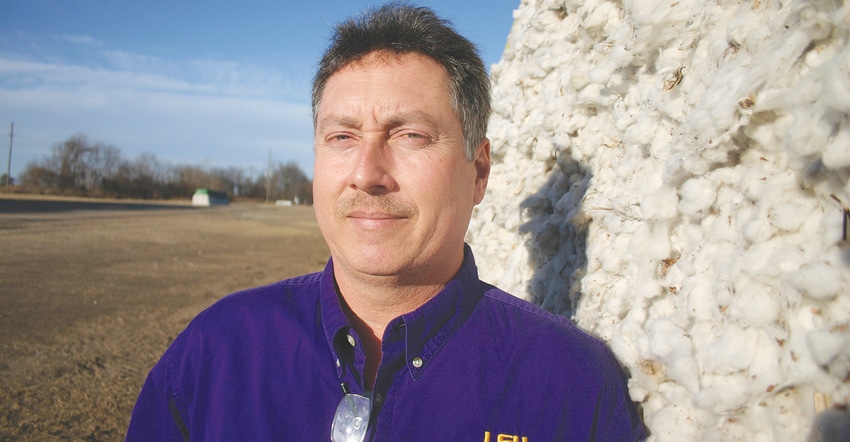
In 2017, the gin staff and farmers in the area surrounding Frogmore, La., were very excited about the cotton crop.
“We had around 13,000 to 14,000 acres of cotton,” says ginner Randy Ainsworth, past president of the Southern Cotton Ginners Association. “With the varieties we have now, we were looking forward to a good ginning season, with the expectation that we’d have the yield to gin 25,000-plus bales.”
Unfortunately, things didn’t work out so well.
“We had a lot of rain in the spring that delayed some planting,” he says. “That meant our crops were not ready at the same time. In turn, that made for a long harvest, which really stretched the ginning season. We began ginning Sept. 26 and finished December 4, just a couple of days after picking was completed. Ginning season was dragged out so much, in fact, that we only ran a night crew for one night.”
Another factor, says Ainsworth, was August rains that lasted for a little over two weeks and “ruined a bunch of the cotton — especially the early-maturing fields. The later crop was a bit better, but not much. So, off of around 14,000 acres, we ended up ginning a little over 19,000 bales.
“That end result was devastating to our expectations. We had our hopes up for a good year. Add the price drop for cottonseed to a weak crop, and it made for a depressing time for us.”
That wasn’t the case for other cotton-producing areas. “I think the poorer conditions for cotton mostly hit us in south Louisiana,” Ainsworth says. “Once you got north of I-20, the crop was better. I have a friend who gins at Rayville, and he says some of the cotton north of I-20 was exceptional. I’m happy for them, but we were hurt in isolated pockets in the south.”
2018 EXPECTATIONS
Interviewed in early January, he said things “are a little different for this time of year, because folks aren’t talking a lot about their plans for 2018.
“I think they’re keeping their powder dry because we’ve had two poor cotton crops in a row. Unfortunately, the farmers in our area have a bad taste in their mouths. Even with the price of cotton inching up a little, farmers aren’t being quick to jump.
“Again, I believe it’s a regional thing. Friends north of I-20 are talking about having more cotton acres in 2018.”
Two bad years in a row is an outlier for the Frogmore area. “That’s especially true with some of the new varieties being planted,” Ainsworth says. “The varieties are awesome — it’s nothing to hear about fields yielding three-bale and four-bale cotton. But we can’t make 1.5-bale cotton here? That explains folks’ reluctance to commit.”
COTTONSEED AND FOOD
In 2017, “there weren’t any huge issues that needed to be tackled as a group,” he says of his tenure as SCGA president.
One of the things he believes the ginning industry needs to be focused on is the removal of gossypol (https://en.wikipedia.org/wiki/Gossypol) from cottonseed. “If we can get that done — and researchers are working on it — and get past the red tape, it will really help us.
“If we can start using cottonseed as a food source for human consumption, it would increase seed value. If we let the public know about it, someone might be able to help push the issue over the finish line.
“We need to focus on getting the cottonseed market humming,” Ainsworth says. “That’s one of the things that really hurt us in 2017 — not only did we not have the bales, but cottonseed was just $150 a ton. That was a hard blow to many.
“As an industry, we need to expand cottonseed markets, and we need to get cotton breeders on board, as well. We need to have cotton varieties with a bigger seed size. Cotton farmers receive a good portion of their income from seed rebates, and right now we’re not getting the seed we used to get.
“Ginners have made that point before, but we need to get farmers on board, too. It’s not just the gins losing out on this, it’s the farmers, too — for some, the rebate can be 20 percent of their income.
“I may want more cottonseed,” Ainsworth says, “but it would be wrong not to acknowledge that, over the years, we’ve seen our grades go up along with yields. We’re seeing unprecedented staple length.”
Ainsworth sends 95 percent-plus of the gin’s cottonseed to Planters Cotton Oil Mill at Pine Bluff, Ark. “We’re partners with them,” he says.
What about the next farm bill, for which work is already under way in Congress? “We need to get our cotton payments back,” Ainsworth says. “But, honestly though, I don’t know that it will ever happen. Once you lose something like that, it’s hard to get it back. But I hope there’s at least consideration of those payments — we need them to make cotton more appealing. There needs to be something to bridge the gap that’s stopping folks from planting cotton.
“In Louisiana, there’s nothing really negative going on with the state government. Right now, I see a lot of positives for cotton.”
On the national level, “President Trump has lived up to his word on regulations. The FDA and OSHA are starting to hold up some of the rules, look at them closely, and ask, ‘Why was this passed?’ Deregulation will help the cotton industry by lessening the things we have to do and the money we have to spend. I see that as a positive.”
About the Author(s)
You May Also Like




